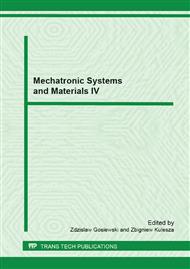[1]
A.R. Girard, A.S. Howell, J.K. Hedrick, Border patrol and surveillance missions using multiple unmanned air vehicles, in Proceedings of the 43rd IEEE decision and control (D. Tilbury), Atlantis, Bahamas, December 14–17, 2004, 620–625.
DOI: 10.1109/cdc.2004.1428713
Google Scholar
[2]
B. Coifman, M. McCord, R.G. Mishalani, M. Iswalt, Y. Ji, Roadway traffic monitoring from an unmanned aerial vehicle, IEE Proc. Intell. Transp. Syst., 153-1 (2006) 11-20.
DOI: 10.1049/ip-its:20055014
Google Scholar
[3]
A. Ryan, J.K. Hedrick, A mode-switching path planner for UAV-assisted search and rescue, in Proceedings of the 44th IEEE conference on decision and control (M. Dawn), Seville, Spain, December 12-15, 2005, 1471-1476.
DOI: 10.1109/cdc.2005.1582366
Google Scholar
[4]
D.W. Casbeer, D.B. Kingston, R.W. Beard, T.W. McLain, Cooperative forest fire surveillance using a team of small unmanned air vehicles, Int. J. Syst. Sci., 37-6 (2006) 351–360.
DOI: 10.1080/00207720500438480
Google Scholar
[5]
K. Peng, G. Cai, B.M. Chen, M. Dong, K.Y. Luma, T.H. Lee, Design and implementation of an autonomous flight control law for a UAV helicopter, Automatica, 45 (2009) 2333-2338.
DOI: 10.1016/j.automatica.2009.06.016
Google Scholar
[6]
J. S. Dittrich, E. N Johnson, Multi-sensor navigation system for an autonomous helicopter. Proceedings of 21st digital avionics systems conference. Irvine, California, USA, 2002, 8C1, p.1–19.
DOI: 10.1109/dasc.2002.1052941
Google Scholar
[7]
V. Gavrilets, A. Shterenberg, M. A. Dahleh, E. Feron, Avionics system for a small unmanned helicopter performing aggressive maneuvers. Proceedings of 19th digital avionics systems conference. Philadelphia, USA, 2000, 1E2 p.1–7.
DOI: 10.1109/dasc.2000.886895
Google Scholar
[8]
B. Mettler, Identification modeling and characteristics of miniature rotorcraft. Norwell, MA, Kluwer Academic Publishers. (2003).
Google Scholar
[9]
M. Dong, B. M. Chen, G. Cai, K. Peng, Development of a real-time onboard and ground station software system for a UAV helicopter. Aerospace Comput Inform Commun, 2007, 4, p.933–955.
DOI: 10.2514/1.26408
Google Scholar
[10]
M. La Civita, W. C. Messner, T. Kanade, Modeling of small-scale helicopters with integrated first-principles and system-identification techniques. Proceedings of 58th forum of American helicopter society. Montreal, Canada, 2002. p.2505–2516.
Google Scholar
[11]
D. H. Shim, H. J. Kim, S. Sastry, Control system design for rotorcraft-based unmanned aerial vehicle using time-domain system identification. Proceedings of IEEE conference on control applications. Anchorage, Alaska, USA. 2000. p.808–813.
DOI: 10.1109/cca.2000.897539
Google Scholar
[12]
E. N. Johnson, S. K. Kannan, Adaptive trajectory control for autonomous helicopters. AIAA Guidance Control Dyn., 2005, 28, p.524–538.
DOI: 10.2514/1.6271
Google Scholar
[13]
M. Sugeno, I. Hirano, S. Nakamura, S. Kotsu, Development of an intelligent unmanned helicopter. Proceedings of IEEE international conference on fuzzy systems. Yokohama, Japan, 1995. p.33–34.
DOI: 10.1109/fuzzy.1995.410029
Google Scholar
[14]
P. Corke, An inertial and visual sensing system for a small autonomous helicopter. Robotic Systems, 2004, 21, p.43–51.
DOI: 10.1002/rob.10127
Google Scholar
[15]
F. Lin, B. M. Chen, K. Y. Lum, Integration and implementation of a low-cost and vision UAV tracking system. Proceedings of 26th Chinese control conference. Zhangjiajie, China, 2007. p.731–736.
Google Scholar
[16]
L. Mejias, S. Saripalli, P. Campoy, G. S. Sukhatme, Visual servoing of an autonomous helicopter in urban areas using feature tracking. Field Robotics, 2006, 23, p.185–199.
DOI: 10.1002/rob.20115
Google Scholar
[17]
G. M. Hoffmann, H. Huang, S. L. Waslander, C. J. Tomlin, Precision flight control for a multi-vehicle quadrotor helicopter testbed. Control Engineering Practice, 2011, 19, pp.1023-1036.
DOI: 10.1016/j.conengprac.2011.04.005
Google Scholar
[18]
D. Aleksandrov, I. Penkov, in 11th Int. Symp. Topical Problems in the Field of Electrical and Power Engineering, Pärnu, Estonia, January 16-21, 2012, 259 – 262.
Google Scholar
[19]
P. Pounds, R. Mahony, P. Corke, Modeling and control of a large quadrotor robot, Control Engineering Practice, 18-7 (2010) 691-699.
DOI: 10.1016/j.conengprac.2010.02.008
Google Scholar
[20]
J. Hines, SolidWorks Flo Simulation, Dassault Systems, Concord, (2011).
Google Scholar
[21]
S. Yongjie, Z. Qijun, F. Feng, X. Guohua, A New Single-blade Based Hybrid CFD Method for Hovering and Forward-flight Rotor Computation, Chi. Jour. of Aeronautics, 24 (2011) 127-135.
DOI: 10.1016/s1000-9361(11)60016-2
Google Scholar
[22]
A.L. Pape, P. Beaumier, Numerical optimization of helicopter rotor aerodynamic performance in hover, Aerospace Sci. and Techn., 9 (2005) 191–201.
DOI: 10.1016/j.ast.2004.09.004
Google Scholar


